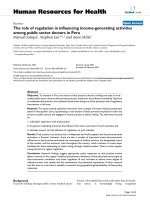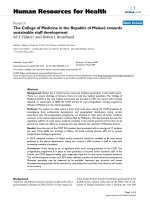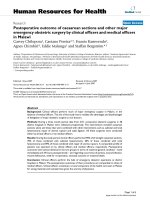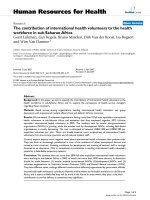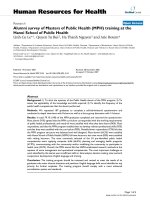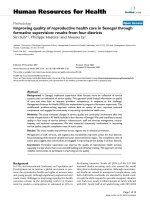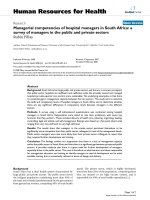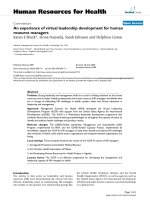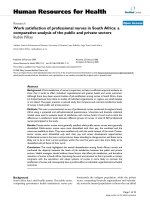báo cáo sinh học:" International flow of Zambian nurses" ppt
Bạn đang xem bản rút gọn của tài liệu. Xem và tải ngay bản đầy đủ của tài liệu tại đây (223.65 KB, 5 trang )
BioMed Central
Page 1 of 5
(page number not for citation purposes)
Human Resources for Health
Open Access
Commentary
International flow of Zambian nurses
Naomi Hamada*
1
, Jill Maben
2
, Barbara McPake
3
and Kara Hanson
4
Address:
1
Independent Researcher, Gifu, Japan,
2
King's College, London, National Nursing Research Unit, Florence Nightingale School of Nursing
and Midwifery, London, UK,
3
Institute for International Health and Development, Queen Margaret University, Edinburgh, UK and
4
Health
Economics and Financing Programme, London School of Hygiene and Tropical Medicine, London, UK
Email: Naomi Hamada* - ; Jill Maben - ; Barbara McPake - ;
Kara Hanson -
* Corresponding author
Abstract
This commentary paper highlights changing patterns of outward migration of Zambian nurses. The
aim is to discuss these pattern changes in the light of policy developments in Zambia and in receiving
countries.
Prior to 2000, South Africa was the most important destination for Zambian registered nurses. In
2000, new destination countries, such as the United Kingdom, became available, resulting in a
substantial increase in migration from Zambia. This is attributable to the policy of active
recruitment by the United Kingdom's National Health Service and Zambia's policy of offering
Voluntary Separation Packages: early retirement lump-sum payments promoted by the
government, which nurses used towards migration costs.
The dramatic decline in migration to the United Kingdom since 2004 is likely to be due to increased
difficulties in obtaining United Kingdom registration and work permits. Despite smaller numbers,
enrolled nurses are also leaving Zambia for other destination countries, a significant new
development.
This paper stresses the need for nurse managers and policy-makers to pay more attention to these
wider nurse migration trends in Zambia, and argues that the focus of any migration strategy should
be on how to retain a motivated workforce through improving working conditions and policy
initiatives to encourage nurses to stay within the public sector.
Introduction
Nurses and midwives constitute the largest of the health
professional groups in Zambia and other low-income
countries. Therefore it is the attrition and movement of
such workers, particularly through migration, that can
cripple a health system in sub-Saharan African countries.
There has been a considerable volume of analysis and
commentary on migration trends of health workers from
Africa to the United Kingdom and other well-resourced
countries in the early 2000s, but little detailed mapping
and analysis with data from African 'sending' countries.
Since that period, it is clear that the situation has changed
significantly (Fig 1), with dramatic increases in nurse
migration from 2000 to 2004.
This paper addresses the factors involved in trends both
before and after that change, using a detailed analysis of
Published: 11 November 2009
Human Resources for Health 2009, 7:83 doi:10.1186/1478-4491-7-83
Received: 2 June 2008
Accepted: 11 November 2009
This article is available from: />© 2009 Hamada et al; licensee BioMed Central Ltd.
This is an Open Access article distributed under the terms of the Creative Commons Attribution License ( />),
which permits unrestricted use, distribution, and reproduction in any medium, provided the original work is properly cited.
Human Resources for Health 2009, 7:83 />Page 2 of 5
(page number not for citation purposes)
data from Zambia, 1991-2005. Thus the aim of the paper
is to examine the impact of policy on changes in the Zam-
bian nursing workforce, including substantial changes in
the migration patterns of Zambian nurses.
Methods
We used the number of nurses requesting verifications
from the General Nursing Council (GNC) in Zambia as an
indicator of nurses' intention to leave the country. Pri-
mary data at the GNC were hand searched, collated and
analysed in Zambia by one of the present authors (NH).
Any nurse wishing to practise abroad must be registered
with the professional regulatory authority of the destina-
tion country. In the case of the United Kingdom, for
example, a verification letter from the GNC in Zambia is
required to confirm that the applicant is competent to
undertake safe and effective practice when nurses apply
for registration with the United Kingdom's Nursing and
Midwifery Council (NMC).
Data on Zambian nurses registering with the United King-
dom NMC were also collected and analysed as part of this
study. These data were compared with the number of
Zambian nurses applying to the Zambian GNC for United
Kingdom verification documents.
Discussion
Migration trends over time
Figure 1 illustrates the number of Zambian registered
nurses (RNs) requesting verification from the GNC for the
top eight destination countries (Australia, Botswana,
Namibia, New Zealand, South Africa, Swaziland, the
United Kingdom of Great Britain and Northern Ireland
and the United States of America).
Prior to 2000, South Africa was the most important single
destination. Since 2000, the substantial increase in migra-
tion is attributable to access to new destination countries
such as Australia, New Zealand, the United Kingdom and
the United States, in addition to established destination
countries such as Botswana and South Africa. Botswana
has long been popular, especially among registered mid-
wives (RMs): higher salary, proximity to home, better
housing and provision of uniforms were often cited as
attracting Zambian nurses [1].
Number of RNs requesting verifications from the GNC for the top eight destination countries (1991 2005)Figure 1
Number of RNs requesting verifications from the GNC for the top eight destination countries (1991 2005).
0
50
100
150
200
250
300
350
400
450
1991 1992 1993 1994 1995 1996 1997 1998 2000 2002 2003 2004 2005
Source : GNC, 2005
1.UK 2.South Africa 3.Botswana 4.USA 5.New Zealand 6.Australia 7.Namibia 8.Swaziland
Change of
immigration
policy in
South Africa
A
ctive international
recruitment policy
in the UK
Reduction of
demand and
increasing of
barriers in the
UK
Human Resources for Health 2009, 7:83 />Page 3 of 5
(page number not for citation purposes)
Countries within the Southern African region are also
used as stepping stones to migrate to the United Kingdom
and elsewhere. By 2000 the United Kingdom replaced
South Africa as the most popular destination country.
The dramatic increase from 2000 is also attributable to the
active recruitment policy of the United Kingdom's NHS
and Zambia's Voluntary Separation Package (VSP), an
early retirement lump-sum payment promoted by the
government, used by some nurses to pay migration fees
and flight costs.
However, since 2004 there has been a dramatic decline in
migration, especially to the United Kingdom, the most
popular destination country. The overall reduction since
2004 is likely to be related to increased difficulties in
obtaining registration and work permits in the United
Kingdom.
Sending country verifications and registration with the
United Kingdom NMC
Table 1 compares the number of Zambian nurses apply-
ing to the Zambian GNC for United Kingdom verifica-
tions with those registering with the NMC in the United
Kingdom. The numbers applying for verifications corre-
spond quite closely with the numbers of Zambian nurses
registering with the NMC (United Kingdom), with a one-
year time lag.
This time lag is a plausible gap between applying for veri-
fication in Zambia and formal admittance to the United
Kingdom's NMC register. During this time, nurses must
complete paperwork, move to the United Kingdom and
undertake three to six months of supervised practice.
However, there are some discrepancies between these two
datasets, most importantly the 76 nurses who seem not to
have registered with the NMC in 2004-2005, despite hav-
ing applied to the GNC for verification letters in 2003. The
shortage of supervised-practice places and greater difficul-
ties in obtaining visas may account for this failure to
absorb the supply in 2004-2005 [2], although the will to
migrate remained. Some may have registered in 2005-
2006, as the registration process is valid for two years.
Overall, however, our data suggest that sending country
(GNC) verifications are a good indicator of actual migra-
tion.
Ethical recruitment policies
A new South African immigration policy introduced in
1994 may have led fewer nurses to migrate to South Africa
between 1994 and 1999. This policy aimed to limit
regional recruitment within the Southern African Devel-
opment Community (SADC) in response to a regional
brain drain into South Africa [3] and appears to have
affected the choice of destination countries for Zambian
nurses.
On the other hand, an active recruitment policy in the
United Kingdom seemed to play a substantial role in
increasing the migration from 2000. This, however, had a
different purpose from the policy in South Africa. In the
United Kingdom, the National Health Service (NHS) was
keen to fill nurse vacancies and had human resources pol-
icies designed to engage in and encourage overseas recruit-
ment, whereas those in South Africa aimed to limit and
create an ethical approach to migration.
The United Kingdom did have an ethical recruitment pol-
icy, yet interestingly the ethical guidelines issued by the
United Kingdom's Department of Health in November
1999 appear to have had no impact: there was a dramatic
increase in migration after their implementation. The
guidelines specifically state that NHS employers should
avoid direct recruitment from South Africa and the Carib-
bean. This resulted in short-term reductions in recruit-
ment from South Africa and the Caribbean, but
recruitment activity may have been displaced to other
developing countries, including Zambia [4].
In 2002 the United Kingdom Department of Health
released a more detailed Code of Practice; in 2003 it
added other countries to a list of less-developed countries
to be avoided, including Zambia. The Commonwealth
also adopted the Code of Practice for the International
Recruitment of Health Workers in 2003. However, there is
no direct evidence that these ethical guidelines were effec-
tive. Indeed a recent evaluation of the Code of Practice
does not identify it as significantly contributing to the
recent drop in migration to the United Kingdom [2].
Enrolled nurses
Although the majority of nurses requesting verifications
are RNs, enrolled nurses (ENs) are also leaving Zambia.
Table 1: Comparison of verification numbers in Zambia and registration numbers in the United Kingdom
Number of nurses applying to GNC (Zambia)
for verifications for the United Kingdom
4
(1998)
44
(1999)
178
(2000)
152
(2001)
167
(2002)
238
(2003)
170
(2004)
Numbers of nurses registering with the
NMC (United Kingdom)
15 (1998/1999) 40
(1999/2000)
88
(2000/2001)
183(2001/
2002)
133
(2002/2003)
169
(2003/2004)
162
(2004/2005)
Source: GNC and NMC, 2005. The numbers applying for verifications correspond quite closely with the numbers of Zambian nurses registering
with the NMC (United Kingdom), with a one-year time lag.
Human Resources for Health 2009, 7:83 />Page 4 of 5
(page number not for citation purposes)
Figure 2 shows the number of Zambian ENs requesting
GNC verifications for the top eight destination countries.
The United Kingdom is the most popular destination
country for RNs, but ENs favour New Zealand and, more
recently, Swaziland. New Zealand may be more popular
among ENs because it retains their cadre, which no longer
exists in the United Kingdom, therefore most ENs leave
for countries other than the United Kingdom.
In contrast to the reductions in RN verifications in 2004
and 2005, EN verifications increased substantially in 2002
and more recently in 2005. While EN migration mirrored
RN migration between 2002 and 2004, by falling sharply,
the trends for the two cadres diverged in 2005. It is not
clear what the causes of the initial decline were, as the
United Kingdom had not been the major recipient coun-
try and explanations for RN decline do not therefore
apply. It is also not clear why this decline reversed again
in 2005 - whether the principal cause was push factors in
Zambia or pull factors in the recipient country.
As Fig 1 and Fig 2 show, the majority of nurses requesting
verifications are RNs. Discussion of nurse migration has
tended to focus on RNs. However, despite the smaller
number of enrolled nurses requesting verifications, the
analysis of enrolled nurse data presented in this paper is
an important new finding and suggests all professional
levels of nursing cadres can migrate, not just RNs.
Conclusion
Comparison between sending country verifications and
registration with the United Kingdom NMC provides new
insights into nurse migration. Furthermore, our data sug-
gest that the number of migrants is determined by active
recruitment policies or those restricting migration in des-
tination countries. South African immigration policy
aimed to limit regional recruitment within the Southern
African Development Community (SADC) and an active
recruitment policy in the United Kingdom seemed to play
a substantial role in influencing migration patterns. On
the other hand, the ethical guidelines issued by the United
Kingdom's Department of Health and the Code of Prac-
tice adopted by the Commonwealth appear to have had
little or no impact on migration patterns.
For the first time, the data in this paper confirm the declin-
ing trend in Zambian nurses migrating to South Africa
1994-1999. This supports Arango's assertion that restric-
tive entry policies are currently much more influential
than differential wages in determining migration [5].
Although migration to South Africa was reduced, the
change of immigration policy by one destination country
does not significantly affect the number of migrants from
a specific country, as long as substantial push factors and
migration opportunities in other destination countries
remain. For example, migration to the United Kingdom
Number of ENs requesting verifications from the GNC for the top eight destination countries (1991 2005)Figure 2
Number of ENs requesting verifications from the GNC for the top eight destination countries (1991 2005).
0
20
40
60
80
100
120
140
1991 1992 1993 1994 1995 1996 1997 1998 2000 2002 2003 2004 2005
Source : GNC, 2005
5.UK 1.South Africa 3.Botswana 2.New Zealand 6.USA 4.Australia 7.Namibia 8.Swaziland
Publish with Bio Med Central and every
scientist can read your work free of charge
"BioMed Central will be the most significant development for
disseminating the results of biomedical research in our lifetime."
Sir Paul Nurse, Cancer Research UK
Your research papers will be:
available free of charge to the entire biomedical community
peer reviewed and published immediately upon acceptance
cited in PubMed and archived on PubMed Central
yours — you keep the copyright
Submit your manuscript here:
/>BioMedcentral
Human Resources for Health 2009, 7:83 />Page 5 of 5
(page number not for citation purposes)
dramatically increased in 2000-2003, even after migration
to South Africa was reduced.
In 2006, the United Kingdom removed entry-level staff
nurses and senior staff nurses from the shortage-occupa-
tion list that allows employers to hire overseas staff more
easily [6]. After this rule change, about one third of the
United Kingdom members of the Philippines Nurses
Association said they were applying for jobs elsewhere,
e.g. Australia.
As Figs 1 and 2 suggest, there are many potential destina-
tion countries for nurses; agreeing upon a quota of nurses
with only the main destination countries will not be suf-
ficient to halt migration trends entirely. Despite the
potential effects of restricting migration through multilat-
eral agreements, this kind of control-oriented policy does
not address the micro-level issues that are the root causes
of migration.
Kingma argues that restrictive immigration policies vio-
late an individual's rights to make international moves,
while neglecting the root causes of migration [7]. Policy-
makers tend to focus on migration restriction as a reten-
tion strategy. However, we suggest the focus of any reten-
tion strategies should be on how to retain a motivated
workforce through improving working conditions and
using policy initiatives to encourage nurses to stay within
the public sector [1].
Finally, despite the fact that the majority of migrants are
RNs, policy-makers should also pay attention to ENs, who
migrate to different destination countries, yet whose
migration also contributes to the loss of skilled health
workers from low-income countries.
Competing interests
The authors declare that they have no competing interests.
Authors' contributions
All authors have been involved in the analysis and writing
of this paper. NH was also responsible for the initial data
collection at the GNC (Zambia) and NMC and coordi-
nated the writing of this paper. JM and BM were supervi-
sors of the research and KH was an advisory group
member. All authors have seen and approved the final ver-
sion.
Acknowledgements
This paper arises from research funded by the Swedish International Devel-
opment Agency (SIDA).
References
1. Toyoshi-Hamada N: Zambian public sector nurses' incentives
and motivation in the context of migration: how to retain
Zambian nurses? In PhD thesis London School of Hygiene and
Tropical Medicine; 2007.
2. Buchan J: The Impact of the Department of Health, England, Code of Prac-
tice on International Recruitment Edinburgh: Queen Margaret Univer-
sity; 2007.
3. Padarath A, Chamberlain C, McCoy D, Ntuli A, Rowson M, Loewen-
son R: Health Personnel in Southern Africa: Confronting
maldistribution and brain drain. Equinet Discussion Paper, no.4.
Harare: Equinet 2003.
4. Buchan J: International recruitment of nurses: United Kingdom case study
Edinburgh: Queen Margaret University; 2002.
5. Arango J: Explaining migration: a critical view. International
Social Science Journal 2000, 52(165):283-296.
6. O'Dowd A: Have We Failed Overseas Nurses? Nursing Times
2006, 102(43):20-21.
7. Kingma M: Nurses on the Move New York: ILR Press Cornell Univer-
sity Press; 2006.
